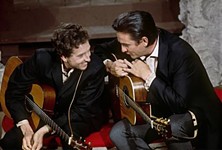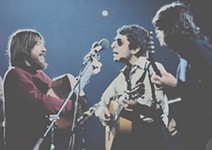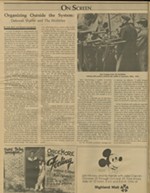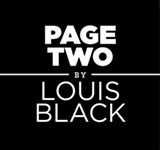That’s So Cool: Celebrating Bob Johnston
The late producer’s staggering output somehow excluded his own renown
By Louis Black, 1:05PM, Thu. Aug. 20, 2015
Bob Johnston, who died Aug. 14, was all energy. Delicately wired, he was lightning in a bottle always on the verge of escaping. He would start off all aglow on one topic then be tripping along covering a dozen more, offering fragments rather than wholes, beginning stories only to wander into a dozen tangents on his way to forgetting the point he started to make.
Still, he was always there – ever immediate.

Which might be what made him such a great producer. He was on-target but wrapped in the cosmos. He was focused on the details, but only as they contributed to a coherent universe of sound.
And the stories begun and veered from and returned to. What stories they were:
“I had 27 artists I was working with, the Byrds on the coast, Patti Page, and the ones in New York. I didn’t know where I was. I knew I loved it, and I would sleep going out to Long Island in a limo to fix breakfast for the kids. I’d see them, turn around, and sleep on the ride back into town. That’s the sleep I got for two or three years.
“During this period, I had Simon at night, and Dylan in the day most of the time, or afternoon. I wanted to do Leonard Cohen in Nashville. I think I ended up doing Dylan down there first, with Blonde on Blonde.
“After Leonard Cohen, I did Cash. I might have done Cash before Dylan even. You’d have to check out the records, see which ones came out, but it was one of those.”
“Johnston lived on low country barbecue, and he was all charm,” is how Dylan recalled him in Chronicles. He continues:
“Johnston had fire in his eyes. He had that thing that some people call momentum. You could see it in his face, and he shared that fire, that spirit. Columbia’s leading folk and country producer, he was born 100 years too late. He should have been wearing a wide cape, a plumed hat, and riding with his sword held high. Johnston disregarded any warning that might get in his way.”
But it wasn’t just his eyes. He was all afire. Johnston defined dynamic. Which resulted in innumerable masterpieces, but he could wear out any listener when talking to them.
In a period stretched over a little more than two decades, Johnston produced seven Bob Dylan albums beginning with Highway 61 Revisited in 1965 (except for “Like a Rolling Stone” ) and Blonde on Blonde through John Wesley Hardin, Nashville Skyline, New Morning, and Self Portrait. He helmed Sounds of Silence and Parsley, Sage, Rosemary and Thyme for Simon & Garfunkel. When Johnny Cash said he wanted to record an album in prison, Johnston ignored the powers that be at Columbia in recording live at San Quentin and Folsom. He produced Songs from a Room, Songs of Love and Hate, and Live Songs for Leonard Cohen.
As well as producing the cult classic Dino Valente, not to mention the drunken, stoned masterpiece Colonel Jubilation B. Johnston & His Mystic Knights Band and Street Singers Attack the Hits, he recorded albums with Marty Robbins, Moby Grape, John Mayall, Joe Ely, Tracy Nelson, Lindisfarne, Loudon Wainwright III, the Poco Seco Singers, Byrds, Doug Kershaw, Wayne Toups, and Billy Joe Shaver. He presided over the albums clustered around Flatt & Scruggs’ break-up and launched Michael Martin Murphey.
When Harold Eggers first introduced me to Bob Johnston, I knew who he was because he had produced Moby Grape’s Truly Fine Citizen. I was and am a bit of a Moby Grape fanatic. Ironically, this turned out to be among the least notable and important of his credits. Later he would tell me that the only way the members of the Grape could get the money to record an album was if Johnston agreed to produce. He said he actually didn’t have much to do with it besides sitting in on sessions.
Johnston always downplayed his credits.

Where others bragged, he denied. Producers involved with far fewer classic albums than Johnston strutted their stuff across the music world’s stage while Johnston worked day and night for over 20 years, producing innumerable masterpieces and downplaying his role in creating them at every turn. He also led and played with Leonard Cohen’s band on two world tours.
I can tell you about the Bob Johnston I knew a couple of decades after his glory days were behind him. He still exploded across the room, still bubbled over with opinions and ideas. As Cohen said, “Let’s sing another song, boys, this one has grown old and bitter.”
Johnston was never bitter.
In a way, that was the most confounding thing about him. He always had more plans for tomorrow, plans to create his own record label and to find new artists — to change the business by driving the money lenders from the recording studios and returning them to the musicians. Unrealistic plans based in no reality that he would spin at greater and greater length, more fantasy than reality. His story was often confusing because to him, his glorious, very real past was merely a backdrop to his overwhelmingly stocked but mostly imagined next act.
In light of what he accomplished, who he worked with, and where he was, his reluctance to take credit actually proved detrimental to his well-earned but underserved legend. The stories poured out of him like automatic weapon fire. On Dylan and the Beatles:
“Ended up at the Mayfair Hotel in London with the Beatles up on the bed. They came to see his concert. I remember that the Beatles walked in to see Dylan in his room. He talked to ’em all night. He’d come back and forth, but he’d talk.
“When the Beatles left his bedroom, they weren’t the Beatles anymore. They were John Lennon, George Harrison, Paul McCartney, and Ringo Starr – in terms of how they thought of themselves.
“That’s who they were; they were different people. It went from there. You can check it: when that happened, how it happened, what happened.”
On meeting Johnny Cash:
“He asked me to come see him one day out at his place. I went.
“‘Come jump in the boat, we’ll go over there to that little land,’ he said.
“‘Man, I wouldn’t boat with you!’ I said, ‘Are you kidding me? I’ll walk across there.’
“I jumped across a couple of logs, got out there. Johnny got there. We talked together. He said, ‘Tell me what’s going happen with me.’ I said, ‘Sit down.’
“He sat down on a log, and I told him. Fifteen minutes later, we came back.”
On playing mental institutions in Europe while on tour with Leonard Cohen:
“Leonard wanted to play some asylums because he was in a bin one time. So we played four, five, six asylums or something. Goddamn, there was one place – big place – and they rolled all these wheelchairs down: UUUHH! People like that, waving and all. They had made a pact: At a certain time they would all piss their pants!
“While Leonard’s singing, they all piss their pants. The nurse and interns came and got them, and were wheeling them out – UUHH! Screaming and crying. Leonard was trying to get them to bring them back in, but they wheeled them out anyway.
“We played in a place called the Purple Dome room. They had maybe 20 or 30 crazies in there. They locked the doors, and we got in there with our guitars. First song we played was ‘Marianne,’ and [it] will never be played like that again, and we all knew it. The rest of eternity, it would never be played that good.
“We finish, and EERRHH! EERRHH!! One guy was scraping his chair up and down. Leonard said, ‘Look at that! Look at how they love us!’ We went into the second song. About the 10th song, it was a symphony! EERRHHEERRHH! BANG! BANG!! All of them making different sounds while we were playing.
“When we got ready to leave, they wouldn’t let us, so the interns had to straightjacket a couple people.”


This is an obituary and a eulogy. It’s a song of contradictions and a long wail into a dark night. A celebration of a force of nature and a great career. And it needs to talk of the man, but how does it do that when I’m still wrapping my head around those stories.
Bob Johnston talking about Bob Dylan recording in Nashville – his first cut for Blonde on Blonde:
“Dylan showed up and went out into one of the studios there. He just stayed out there, and he never left to go to the bathroom or anything. He ate candy bar after candy bar, all kinds of sweets. All day long.
“Now, these musicians down here in Nashville, they never had seen anything like these sessions. Usually when they had a session, it was around three hours and they recorded five or six songs.
“After three hours, Dylan hadn’t left the studio he was in, nor even stepped into the studio in which we were going to actually record. All the studio musicians had been there all day long. I told everybody, just stay around. Play ping-pong or go to sleep. Periodically I’d check on them, waking the sleeping ones up.
“I did warn them then that when we did start recording, ‘You’re only going to have one chance. If any of you quits playing for any reason, you’re gone, because he’ll never do that song again. I won’t allow that. I’d rather sacrifice you than have him affected. I want to stay with him, because what he’s got to say is important! More important than you will ever know! Important 30 or 40 years down the road or even 500 years down the road.’
“I think he’s the only prophet we’ve had besides Christ or Buddha – whatever those guys names are!
“Dylan had been in that studio writing forever. I began thinking that he was a junkie, because he kept eating sweets, and chocolate, Cokes, and different things like that. I had never seen anyone eat that much sugar. I thought, damn, he must really be hooked or something. I didn’t care, but I thought he must be hooked. He wasn’t. He wasn’t hooked on anything but time and space.
“I don’t know what time it was: 2, 3, 4am. Dylan finally came out, looked at me and said, ‘Hey Bob, you still awake?’
“I said, ‘Yeah.’
“‘Is there anyone else awake down there?’ he asked. ‘Who’s around you can get? I think I got something here.’
“‘Yeah man,’ I said, going off to wake them.
“They couldn’t believe it. ‘What?! We’re going to record now?!’
“‘Yeah,’” I answered.
“In about 20 minutes, they were all in there. There wasn’t any turning the machines on. I always had them running. I had commandeered two machines on the way from Chicago. Got them and just turned one on after the other so I’d never lose anything that he played.
“‘I got this song here, it goes like this,’ said Dylan. ‘Nnnn nnnn nnn – C G B,’ or something like that. The poor musicians were always looking at Dylan to see where he put his fingers so they could play the next chord, because he’d say, ‘It goes like this: AAAA, ddddd, aaaa okay?’ Then he’d be off.
“That morning, when we finally got started, he walked back to his place in the back of the recording room. He counted off – nobody ever counted off for Dylan. He was back there, out of nowhere, with no warning. Suddenly, ‘two, three!’ – he started playing the guitar. Everybody else dove in.
“We nailed ‘Sad-Eyed Lady of the Lowlands’ in one take!”

Johnston and I had many recorded talks over the years. I prepared Is It Rolling, Bob? as an as-told-to autobiography, which was turned down by two different university presses. The problem was that Johnston kept hoping Dylan, Cohen, Paul Simon, or Cash would call him to come produce again. As in his heyday, he never took credit for the range of recordings he did because he wanted to celebrate the artists he worked with and not step on their egos. He would tell stories, but he wouldn’t tell all the stories. And the stories he did tell he told to everyone so they were printed everywhere.
Still, after a couple of years of talking, I finally got him to admit his participation. Got him to talk about tuning the studio, about placing the mics and positioning the players. Creating a sound but most important a structure and environment where each artist flourished. He was a fan, an over the top lover of talent who felt his sole purpose was to get everyone he worked with to be so comfortable that they would absolutely deliver their best. From his soul to the performers’ soul there was an electric current that he would switch on.
He would say again and again that he just turned the recording machines on and the artists did the rest. So many music writers believed him, took him at his word. His stunning discography gives lie to that notion. It insists on his involvement and his genius.
Bob Johnston was brilliant and difficult. He was a visionary, and as with most visionaries a bit delusional, but he created an extraordinary body of work. The online book we did just begins to tell his extraordinary story. The great man has left us now. Ironically, I suspect this will be the opening of the door for many works detailing and appreciating his genius.
Since Harold Eggers called me to tell of his passing, I’ve been listening nonstop to Bob Johnston-produced music. One album after the other. The truth is that I’ve barely begun because there are so many. His legacy is listened to all across the world every day. Right now, through all manner of devices and all kinds of speakers, music produced by Bob Johnston is being appreciated. The enormity of his output is so staggering that it somehow left the man responsible for it playing too small a role in his own story.
Steve Earle emailed to say that he was doing a tribute to Johnston on his radio show. He asked what Johnston had produced on the Waterboys’ album Fisherman’s Blues.
I wrote back, “We Will Not Be Lovers.” From Is It Rolling, Bob? – “Johnston only produced one cut on the album, but the band credited him with mentoring them to really understand American music.”
Earle answered:
“That’s what I needed. I was around for some of that record. ‘We Will Not be Lovers’ is my favorite track. That’s so cool.”

A note to readers: Bold and uncensored, The Austin Chronicle has been Austin’s independent news source for over 40 years, expressing the community’s political and environmental concerns and supporting its active cultural scene. Now more than ever, we need your support to continue supplying Austin with independent, free press. If real news is important to you, please consider making a donation of $5, $10 or whatever you can afford, to help keep our journalism on stands.










